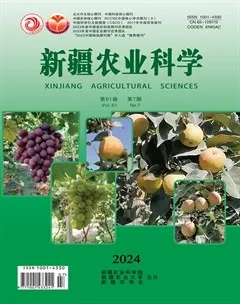棉花-花生轮作模式对土壤养分及其产量的影响
2024-12-31侯献飞李强苗昊翠贾东海顾元国买买提依明•斯马依崔福洋


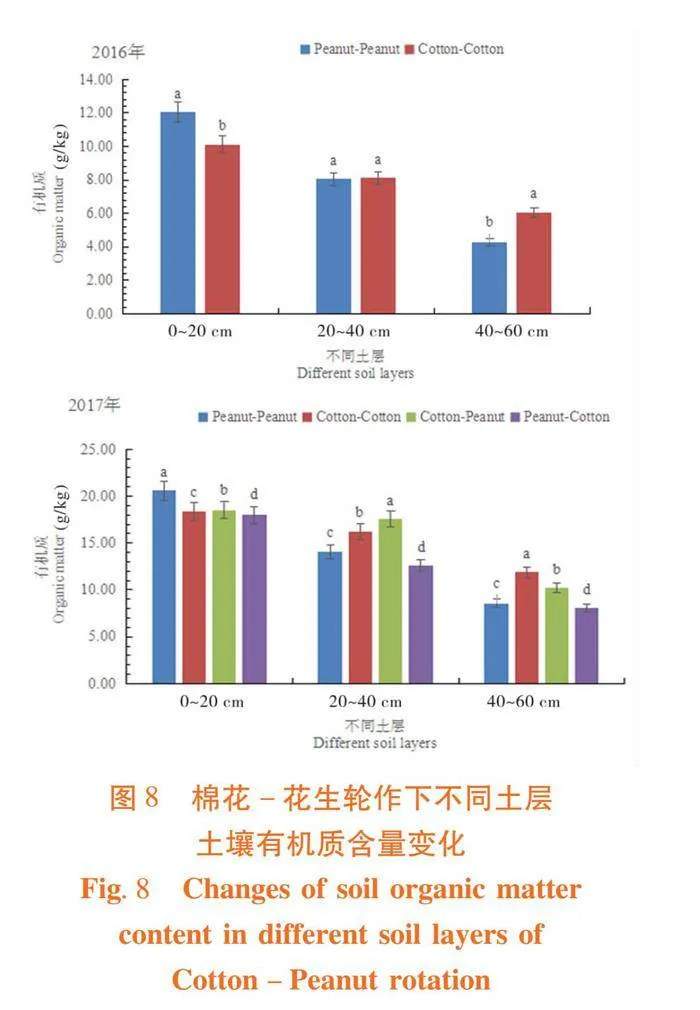
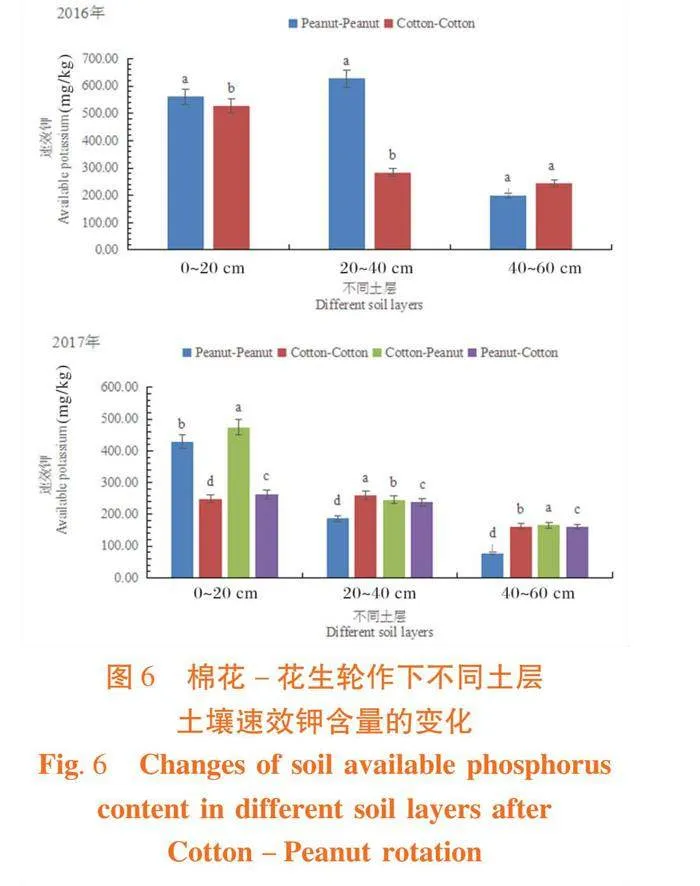
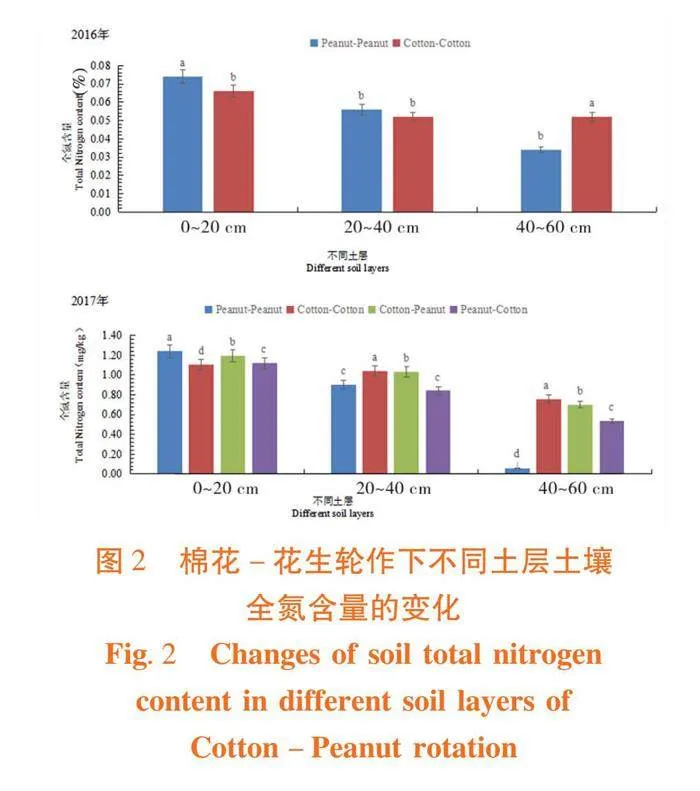

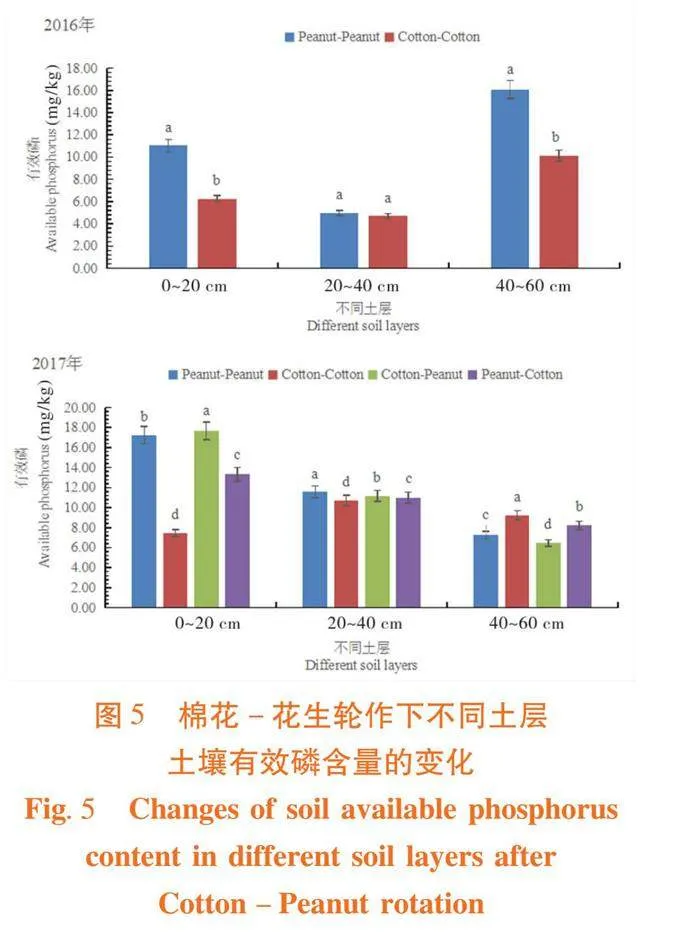
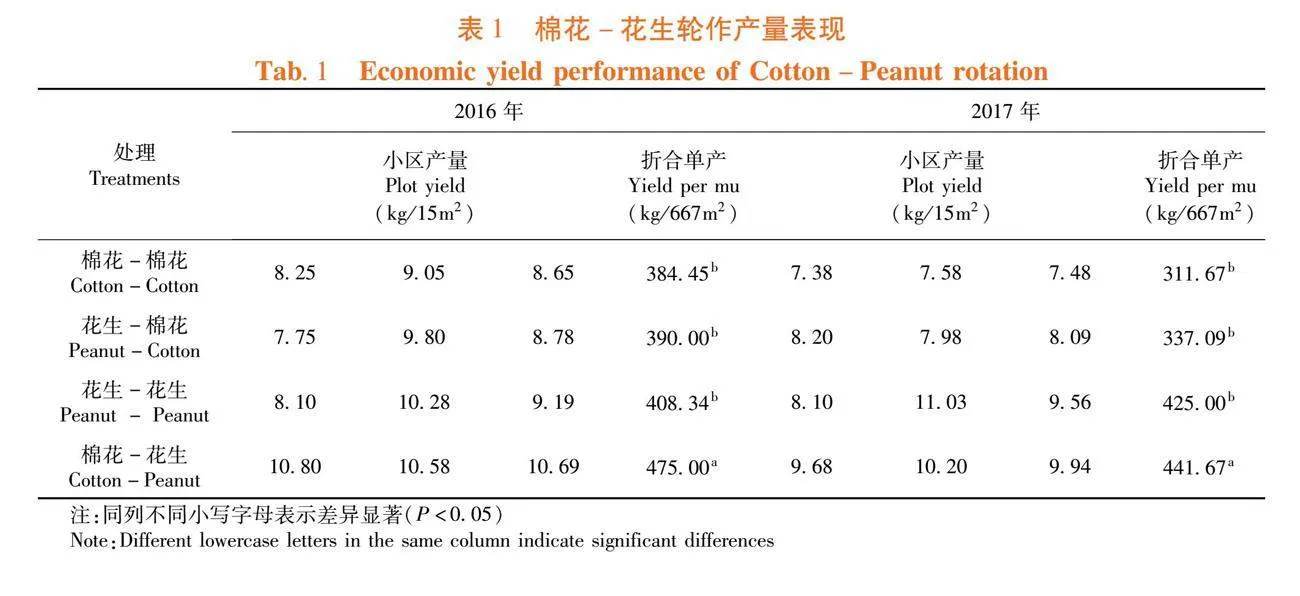
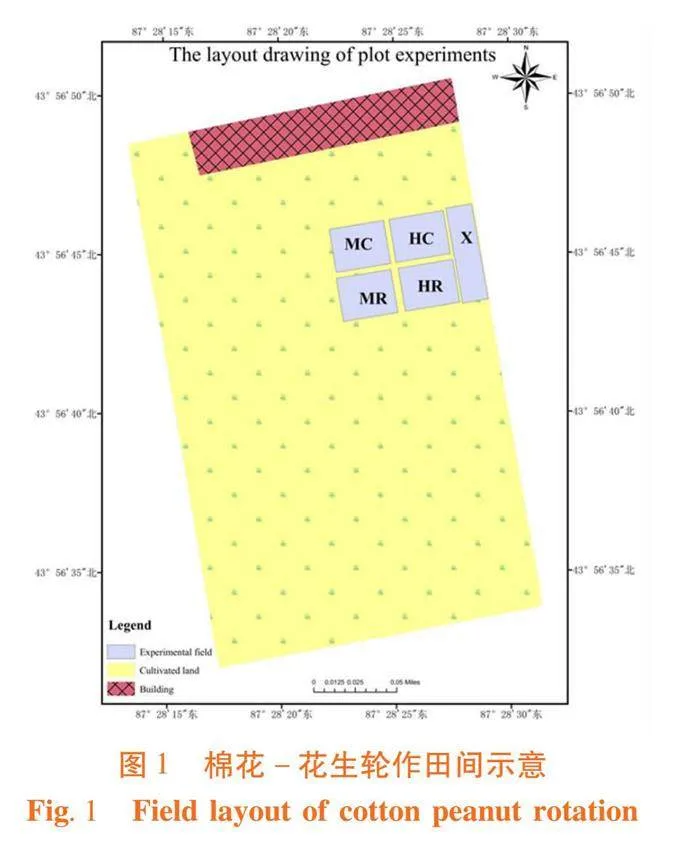
摘 要:【目的】研究棉花-花生轮作模式下土壤养分及作物产量变化规律,为新疆绿洲农区产业结构调整提供一定的理论依据。
【方法】试验为长期定位试验,设棉花-花生、花生-棉花、花生-花生(对照)、棉花-棉花4个处理(对照),于各轮作作物收获后取土样,测定0~20 cm,20~40 cm,40~60 cm土壤有机质、全氮、全磷、全钾、水解氮、有效磷、速效钾含量。
【结果】棉花-花生轮作下,0~20 cm土壤有效磷含量最高,是棉花连作的2倍左右,且土壤速效钾含量明显高于棉花连作,在0~40 cm土层花生连作的土壤全氮含量最高,棉花-花生轮作的土壤水解氮含量最高;棉花-花生轮作的花生、棉花产量均高于连作棉花、连作花生,且棉花-花生轮作,较花生-花生连作的花生增产16.33%;2017年花生-棉花轮作下,棉花产量较棉花轮作增产8.2%。
【结论】棉花-花生轮作模式可以提高连作棉田土壤肥力,提高棉花和花生产量。
关键词:轮作;棉花;花生;土壤养分;产量
中图分类号:S344.1;S15"" 文献标志码:A"" 文章编号:1001-4330(2024)07-1657-09
0 引 言
【研究意义】新疆是我国棉花的主产区,近年来新疆棉花种植面积在2 499×103 hm2左右,占新疆总耕地面积的1/3,新疆棉花面积总产、单产均列全国第一[1]。但随着棉花种植年限的增加,棉花连作时间长将造成土壤养分不均衡、用地养地不协调、土传病害加重[2]。花生是我国主要的经济作物之一,也是重要的油料作物,较耐贫瘠,作为豆科植物,本身具有固氮作用[2、3],可以减少氮肥的使用。棉花-花生间作可以作为一种改善土壤肥力的耕作措施,不仅可以提高作物产量,而且具有一定的生态效益,花生固氮可以为棉花提供氮素,棉花根系可以活化土壤中的磷为花生所吸收[2]。棉花-花生间作过程中存在一定的养分竞争,但棉花-花生轮作可以避免这种养分竞争,研究棉花-花生轮作对土壤速效养分及其产量的影响,对新疆绿洲农区产业结构调整具有实际意义。【前人研究进展】唐朝辉等[4]研究发现,通过甘薯-花生轮作可有效缓解花生连作障碍,提高花生产量和品质;范业赓等[5]研究发现,甘蔗轮作青饲玉米和花生,促进了甘蔗生产提质增效,轮作提高了土壤中微生物数量和相关酶活性,进一步改善了蔗区酸性土壤的pH值,加速土壤有效养分的释放,在促进甘蔗的生长发育的同时缓解连作障碍。姚凡云等[6]研究发现,半干旱区玉米-花生轮作、秸秆还田改善了作物播前的土壤水分状况,花生种植区土壤平均含水量提高了11.0%~13.9%,同时,玉米-花生轮作模式下,耕地中的速效氮含量将增加,并且豆科作物收获后,残留的作物碎片和腐烂的作物根将释放有机氮化物,从而提高耕地中土壤的有效养分含量。Zhao等[7]研究发现,在农业生产中轮作的模式开展,具有较高的产量和收益,豆科植物与小麦轮作的增产幅度较无豆科植物与小麦轮作高14.0%;李银水等[8]研究发现,花生-油菜轮作周年的产投比均以花生高钾、油菜低钾处理最高,在轮作周年钾肥总用量有限条件下,将钾肥适当前移至花生生长季有利于提高肥料利用率。【本研究切入点】关于新疆棉花-花生轮作后土壤养分变化未见文献报道。需要研究新疆棉花-花生轮作后作物产量变化以及土壤养分变化规律。【拟解决的关键问题】采用多年长期定位试验,分析棉花-花生轮作模式下不同土层土壤的养分变化,以及对作物产量和质量的影响,为新疆耕地用养结合提供一定的理论依据。
1 材料与方法
1.1 材 料
试验点位于新疆乌鲁木齐市新疆农业科学院综合试验场。
试验于2016年5月至2020年5月进行(选择2016~2017年试验数据)。试验地前茬为油菜,土壤为灰漠土,土壤肥力中等,播种前施1.2×104 kg/hm2农家肥及 450 kg/hm2 (NH4)2HPO4用作底肥。棉花品种为新陆早50号,花生品种为花育9610(均由新疆农业科学院经济作物研究所提供)。
棉花、花生后期追肥田间管理按常规进行,氮、磷施用量采用当地最佳施肥量。
1.2 方 法
1.2.1 试验设计
以英国洛桑研究所(Rothamsted Research)长期定位试验为参照,处理包括2个2 年为一轮的轮作模式。
试验为长期定位试验,试验田地势平坦、肥力均匀一致。按轮作作物设棉花-花生,花生-棉花、花生-花生(对照,CK)、棉花-棉花(对照,CK)4个处理。每个处理 3个重复,共15个小区,小区为 12 m×15 m,面积 180 m2,小区间走道 0.5 m,重复间走道 1 m,四周设 1 m 保护行。小区面积1 334 m2,各作物行、株(穴)距按当地高产田标准。采用地膜覆盖栽培,播种及田间管理按当地高产田进行。不同轮作模式、不同处理间每年或每轮作周期施入肥料总量一致。表1,图1
1.2.2 测定指标
各轮作作物收获后取土样,各小区采用5点采样法,采集0~20 cm, 20~40 cm,40~60 cm土层土壤,去杂,自然风干,将5点土壤充分混合后保存500 g。土壤全氮采用凯氏定氮法测定; 土壤全磷测定:HClO4-H2SO4 消煮法;土壤全钾测定:NaOH熔融,火焰光度计法(GB-7854-87);土壤有机质的测定:重铬酸钾容量法; 土壤速效磷测定:0.5 mol L-1NaHCO3; 土壤速效钾测定:NH4OAc 浸提,火焰光度计法。
1.3 数据处理
数据利用 Excel 2010进行整理及图表制作,使用SPSS 19.0统计分析软件进行方差分析,多重比较。
2 结果与分析
2.1 棉花-花生轮作对土壤全氮的影响
研究表明,不同种植模式下,同一土层土壤全氮含量差异显著。2016~2017年随着土层深度的增加,土壤全氮含量降低。2016年花生-花生连作下,随着土层深度的增加土壤中全氮含量降低较显著,而棉花-棉花连作下,土壤全氮含量变化较小,在20~40 cm与40~60 cm土层全氮含量无变化(0.05%);但在0~40 cm土层中,花生-花生连作下土壤全氮含量高于棉花-棉花连作,40~60 cm土层中棉花-棉花连作下土壤全氮含量高于花生-花生连作;2017年在0~20 cm土层,花生-花生连作、棉花-花生轮作下土壤全氮含量高于棉花-棉花连作、花生-棉花轮作,但在20~40 cm土层全氮含量低于棉花-棉花连作、花生-棉花轮作。图2
2.2 棉花-花生轮作下对土壤全磷的影响
研究表明,不同连作下,同一土层土壤全磷含量差异显著。2016年花生试验地土壤全磷含量随着土层深度的增加逐渐增加,而棉花试验地全磷含量变化较小;2017年花生-花生连作、棉花-花生轮作0~20 cm土层全磷含量高于棉花-棉花连作、花生-棉花轮作,且花生-棉花轮作全磷含量最低(0.63 g/kg);在20~40 cm土层花生-棉花轮作全磷含量高于棉花-棉花连作,棉花-花生轮作在40~60 cm土层棉花-棉花连作下土壤全磷含量最高(1.71 g/kg)。图3
2.3 棉花-花生轮作对土壤全钾的影响
研究表明,不同种植模式下,同一土层土壤全钾含量差异显著;在2016年棉花、花生试验地土壤全钾含量变化较小; 2017年花生-花生连作下土壤全钾含量随着土层深度的增加含量降低,而棉花-棉花连作下全钾含量随着土层深度的增加而增加,花生-棉花轮作,棉花-花生轮作下,土壤全钾含量变化趋势一样,但是变化幅度较小;在0~20 cm土层棉花-花生轮作下土壤全钾含量最高(46.70 mg/kg),最低的是花生-棉花轮作(25.12 mg/kg),在20~40 cm土层,棉花-花生轮作下土壤全钾含量最高(23.21 mg/kg),花生-花生连作最低(17.89 mg/kg),棉花主要吸收20 cm土层的钾。图4
2.4 棉花-花生轮作对土壤中有效磷的影响
研究表明,不同种植模式下同一土层土壤有效磷差异显著。2016年不同土层土壤有效磷含量在花生-花生连作下最高,在20~40 cm土层,棉花-棉花连作有效磷含量与花生-花生连作差异不显著;2017年,在0~20 cm土层中棉花-花生轮作下土壤有效磷含量最高(17.65 mg/kg),其次是花生-花生连作(17.26 mg/kg),棉花-棉花连作最低(7.45 mg/kg),在20~40 cm土层下,花生-花生连作下土壤有效磷含量最高,其次是棉花-花生轮作,而在40~60 cm土层棉花-棉花连作下土壤有效磷含量最高,棉花主要吸收0~20 cm土层的有效磷,花生主要吸收40~60 cm土层的有效磷。图5
2.5 棉花-花生轮作对土壤中速效钾的影响
研究表明,不同种植模式下同一土层土壤速效钾差异显著。2016年在20~40 cm土层中差异较大;而在40~60 cm土层中花生-花生连作的速效钾小于棉花-棉花连作;2017年0~20 cm棉花-花生轮作下土壤速效钾含量最高,棉花-棉花连作下土壤速效钾含量最低,在20~40 cm、40~60 cm土层中花生-花生连作下土壤速效钾含量最低,在20~40 cm含量最高的棉花-棉花连作,在40~60 cm土层中速效钾含量最高的是棉花-花生轮作(78.0 g/kg)。图6
2.6 棉花-花生轮作对土壤中水解氮的影响
研究表明,不同种植模式下同一土层土壤水解氮差异显著。2016年在0~20 cm土层中土壤水解氮在2种种植模式下差异显著,在20~60 cm土层差异不显著;2017年在0~20 cm、20~40 cm土层中棉花-花生轮作下土壤水解氮含量最高,在花生-花生连作下土壤水解氮含量最低;40~60 cm土层中棉花-花生轮作下土壤水解氮含量最高(89.06 mg/kg)。图7
2.7 棉花-花生轮作对土壤中有机质的影响
研究表明,在不同种植模式下,同一土层土壤有机质含量差异显著,2016年花生试验地土壤有机质含量在0~20 cm、20~40 cm土层高于棉花试验地,且在0~20 cm土层差异显著, 而在40~60 cm土层低于棉花试验地;2017年在0~20 cm土层下花生-花生连作有机质含量最高(20.6 g/kg),而20~40 cm土层下棉花-花生轮作有机质含量最高(17.55 g/kg);随着土层深度的增加,土壤有机质含量降低,而棉花-花生轮作下,随着土层深度的增加,土壤有机质含量降低幅度较小。图8
2.8 棉花-花生轮作对作物产量的影响
研究表明,其中2016年、2017年棉花连作产量低于花生-棉花轮作,且差异不显著(P>0.05);棉花-花生轮作下的花生产量高于花生-花生连作,且差异显著(P<0.05),2016年棉花-花生轮作花生单产475.00 kg/667m2,较花生-花生连作增产16.33%;2017年棉花-花生轮作的花生较连作花生增产3.39%。棉花花生轮作较棉花连作,棉花产量均表现增产,其中2016年增产1.4%,2017年增产8.2%。表1
3 讨 论
3.1 棉花-花生轮作对土壤理化性质的影响
土壤氮磷钾以及有机质含量是土壤肥力的主要指标,棉花-花生轮作模式对土壤养分含量的积累和再利用,起到了至关重要的作用。研究表明[9-11],轮作模式有利于减少氮肥的施加,因为一方面豆科植物本身具有固氮的作用,另一方面豆科植物可以将空气中的氮转化成作物所需的氮元素,所以豆科植物的种植对提高土壤中氮含量起着相当重要作用。通过分析轮作模式对土壤中氮含量的影响以及不同深度土壤中氮含量的研究发现,在0~40 cm土层花生连作种植模式下土壤全氮含量最高,棉花-花生轮作下,土壤中水解性氮含量最高,说明棉花-花生轮作可以提高土壤中氮素含量,与郑永美等[12]、田丽彬等[13]、张晓娜等[14]研究花生作物豆科作物在与其他作物间作、轮作过程中具有显著的增氮作用研究结果一致。
Feiziene等[15]研究发现,豆科植物同其他作物轮作过程中,可有效提高土壤有效磷的含量,试实验中,采用棉花-花生轮作模式,土壤中的有效磷含量0~20 cm最高,是棉花连作的2倍左右,花生相对于锦葵科植物更能吸收磷素养分,花生
相对于大豆根际能分泌更多的有机酸,并且吸收钙元素能力强,因此吸收磷元素能力也强。从轮作模式和土层深度进行分析,土层深度可以单独影响土壤有效磷含量,随土层深度的增加,有效磷的含量逐渐降低,不同处理也间接影响土壤有效磷含量,豆科植物根际附着根瘤菌,根瘤菌以磷固氮作用使得土壤磷素均聚集在豆科作物的根际周围,深层的土壤有效磷含量较低。
研究表明[16.17.18],豆科植物对于钾素养分的要求较高,土壤胶体中钾素养分析出较多。研究中棉花-花生轮作且0~20 cm土壤速效钾含量明显高于棉花连作。与此同时豆科作物根瘤菌固氮作用,对于钾素养分需求较高,将土壤中钾素解离出来,提高土壤中速效钾的含量,降低深层土壤中速效钾的含量。
不同作物之间进行轮作可以提高土壤中有机质含量,增强土壤肥力[19-21]。Zuber等[22]、Campbell等[23]研究发现,在作物轮作连作下,增加作物的种类可以显著提高土壤有机物含量,且与休闲地相比,轮作次数越高土壤有机质含量增加越多,主要是因为休闲地、连作的过程中土壤中的有机碳矿化速率增加;研究发现棉花-花生轮作模式下土壤机质含量明显高于棉花连作,花生-棉花轮作,同时发现花生-棉花轮作模式下土壤机质含量低于花生连作,轮作作物的顺序对土壤的有机物含量具有显著的影响,从长期地位试验发现,种植花生收获后,0~20 cm土层的有机质含量高于棉花,种植花生对长期连作的棉田进行轮作倒茬可以增加土壤有机质含量。
3.2 棉花-花生轮作对作物产量及经济效益的影响
不同作物的轮作与连作相比可以有效提高作物产量[24-28],Varvel等[29]研究发现,多作物轮作相对于单一作物连作更能降低产量的波动,与试验研究结果相同。韩丽娜[30]等研究发现,冬油菜-苜蓿轮作2年,冬油菜产量增加了34.9%;轮作可以提高土壤蓄水保墒能力,可以提高作物产量[31.32]。徐文修[33]通过对连作8年以上的棉田进行不同作物轮作倒茬,发现经过不同作物的轮作倒茬,连作棉田的土壤肥力得到提高,棉花产量也得到提升;试验研究发现棉花-花生轮作下花生、棉花的产量均高于棉花、花生连作,且棉花-花生轮作下,较花生-花生连作,花生增产16.33%;花生-棉花轮作下,棉花产量较棉花连作增产9%,与前人研究结果一致。
4 结 论
棉花-花生轮作模式下,0~20 cm土壤有效磷含量最高,是连作棉花的2倍左右,且土壤速效钾含量明显高于连作棉花,在0~40 cm土层花生连作种植模式下土壤全氮含量最高,棉花-花生轮作下土壤水解性氮含量最高;棉花-花生轮作下的花生、棉花产量均高于连作棉花、连作花生,且棉花-花生轮作下,较花生-花生连作的花生增产16.33%;棉花花生轮作较棉花连作,棉花产量均表现增产,其中2016年增产1.4%,2017年增产8.2%。
参考文献(References)
[1]
梁亚军, 李雪源, 郑巨云, 等. 新疆2019年棉花产业情况概述及存在问题与策略[J]. 棉花科学, 2020, 42(1): 14-20.
LIANG Yajun, LI Xueyuan, ZHENG Juyun, et al. Overview of cotton industry situation and existing problems and strategies in Xinjiang in 2019[J]. Cotton Sciences, 2020, 42(1): 14-20.
[2] 杨菲, 刘霞, 李海涛, 等. 不同花生棉花间作配比下的土壤养分、作物产量和收益研究[J]. 山东农业科学, 2021, 53(8): 33-36.
YANG Fei, LIU Xia, LI Haitao, et al. Effects of peanut-cotton intercropping ratio on soil nutrient, crop yield and income[J]. Shandong Agricultural Sciences, 2021, 53(8): 33-36.
[3] Bi Y L, Zhou H L. Changes in peanut canopy structure and photosynthetic characteristics induced by an arbuscular mycorrhizal fungus in a nutrient-poor environment[J]. Scientific Reports, 2021, 11(1): 14832.
[4] 唐朝辉, 郭峰, 张佳蕾, 等. 甘薯花生轮作对花生生理及产量品质的影响[J]. 中国油料作物学报, 2020, 42(6): 1002-1009.
TANG Zhaohui, GUO Feng, ZHANG Jialei, et al. Effect of sweet potato and peanut rotation on physiological characteristics and yield and quality of peanut[J]. Chinese Journal of Oil Crop Sciences," 2020, 42(6): 1002-1009.
[5] 范业赓, 陈荣发, 闫海锋, 等. 甘蔗轮作青饲玉米和花生对甘蔗生长和土壤性状的影响[J]. 作物杂志, 2021, (1): 104-111.
FAN Yegeng, CHEN Rongfa, YAN Haifeng, et al. Effects of sugarcane rotation green fodder corn and peanut on sugarcane growth and soil properties[J]. Crops, 2021, (1): 104-111.
[6] 姚凡云, 曹玉军, 王虹霏, 等. 秸秆还田对东北半干旱区玉米‖花生轮作系统土壤水热特性及作物产量的影响[J]. 玉米科学, 2020, 28(4): 86-95.
YAO Fanyun, CAO Yujun, WANG Hongfei, et al. Effects of straw returning on soil hydro-thermal properties and crop yield of Maize‖Peanut rotation system in semi-arid area of Northeast China[J]. Journal of Maize Sciences, 2020, 28(4): 86-95.
[7] Zhao J, Yang Y D, Zhang K, et al. Does crop rotation yield more in China? A meta-analysis[J]." Field Crops Research, 2020, 245: 107659.
[8] 李银水, 余常兵, 谢立华, 等. 氮钾肥运筹对花生——油菜轮作制作物产量及养分效率的影响[J]. 中国油料作物学报, 2016, 38(6): 817-823.
LI Yinshui, YU Changbing, XIE Lihua, et al. Effect of different nitrogen and potassium fertilizers application allocation on yields and nutrient efficiency in peanut-rapeseed rotation system[J]. Chinese Journal of Oil Crop Sciences, 2016, 38(6): 817-823.
[9] 温延臣, 李海燕, 袁亮, 等. 长期定位施肥对潮土剖面养分分布的影响[J]. 中国农业科学, 2020, 53(21): 4460-4469.
WEN Yanchen, LI Haiyan, YUAN Liang, et al. Effect of long-term fertilization on nutrient distribution of fluvo-aquic soil profile[J]. Scientia Agricultura Sinica, 2020, 53(21): 4460-4469.
[10] 朱梓弘, 朱同彬, 杨霖, 等. 中国土壤碱解氮含量与影响因子的空间关系研究[J]. 生态环境学报, 2019, 28(11): 2199-2207.
ZHU Zihong, ZHU Tongbin, YANG Lin, et al. The spatial relationship between soil alkeline-nitrogen content and environmental factors in China[J]. Ecology and Environmental Sciences, 2019, 28(11): 2199-2207.
[11] 张苏芮, 李一鸣. 小麦—玉米轮作体系下长期秸秆还田对土壤养分含量的影响综述[J]. 现代农业科技, 2020,(7): 189, 192.
ZHANG Surui, LI Yiming. Review on the effect of long-term straw returning to field on soil nutrient content under wheat-maize rotation system[J]. Modern Agricultural Science and Technology, 2020,(7): 189, 192.
[12] 郑永美, 周丽梅, 郑亚萍, 等. 花生主要碳代谢指标与根瘤固氮能力的关系[J]. 植物营养与肥料学报, 2021, 27(1): 75-86.
ZHENG Yongmei, ZHOU Limei, ZHENG Yaping, et al. Relationship between carbon metabolism indices of peanut leaves and nitrogen fixation ability of nodules[J]. Journal of Plant Nutrition and Fertilizers, 2021, 27(1): 75-86.
[13] 田丽彬, 刘译阳, 张佳蕾, 等. 花生结瘤起始因子基因鉴定及其对氮肥的响应[J]. 花生学报, 2020, 49(3): 1-7.
TIAN Libin, LIU Yiyang, ZHANG Jialei, et al. Identification of peanut nodule inception and its response to nitrogen fertilizer[J]. Journal of Peanut Science, 2020, 49(3): 1-7.
[14] 张晓娜, 陈平, 杜青, 等. 玉米/大豆、玉米/花生间作对作物氮素吸收及结瘤固氮的影响[J]. 中国生态农业学报(中英文), 2019, 27(8): 1183-1194.
ZHANG Xiaona, CHEN Ping, DU Qing, et al. Effects of maize/soybean and maize/peanut intercropping systems on crops nitrogen uptake and nodulation nitrogen fixation[J]. Chinese Journal of Eco-Agriculture, 2019, 27(8): 1183-1194.
[15] Feiziene D, Feiza V, Povilaitis V, et al. Soil sustainability changes in organic crop rotations with diverse crop species and the share of legumes[J]. Acta Agriculturae Scandinavica, Section B — Soil amp; Plant Science, 2016, 66(1): 36-51.
[16] 翁颖, 许映君, 崔萌萌, 等. 菜用大豆不同施肥处理试验初报[J]. 浙江农业科学, 2018, 59(12): 2295-2297.
WENG Ying, Xu Yingjun, Cui Mengmeng, et al. Preliminary report of fertilization treatments on vegetable soybean[J]. Journal of Zhejiang Agricultural Sciences, 2018, 59(12): 2295-2297.
[17] 庞泰春. 不同施钾水平对大豆生长及产量的影响[J]. 现代农业科技, 2017,(15): 7-8.
PANG Taichun. Effects of different potassium application level on growth and yield of soybean[J]. Modern Agricultural Science and Technology, 2017,(15): 7-8.
[18] 韩晓增, 胡国华, 邹文秀. 东北地区不同轮作方式下大豆产量对施钾的响应[J]. 土壤与作物, 2014, 3(4): 157-161.
HAN Xiaozeng, HU Guohua, ZOU Wenxiu. The response of soybean grain yield to potassium fertilization under different crop rotations in black soil region of Northeast China[J]. Soil and Crop, 2014, 3(4): 157-161.
[19] West T O, Post W M. Soil organic carbon sequestration rates by tillage and crop rotation[J]. Soil Science Society of America Journal, 2002, 66(6): 1930-1946.
[20] 宋祥云, 宋春燕, 柳新伟, 等. 小麦玉米轮作条件下不同生物质炭对土壤腐殖物质的影响[J]. 土壤学报, 2021, 58(3): 610-618.
SONG Xiangyun, SONG Chunyan, LIU Xinwei, et al. Effects of application of biochar on soil humic substances in cropland under wheat-corn rotation system[J]. Acta Pedologica Sinica, 2021, 58(3): 610-618.
[21] 马欣, 韩宝吉, 张丽梅, 等. 花生-油菜轮作模式下硼肥及其后效对作物产量的影响[J]. 中国油料作物学报, 2018, 40(6): 861-865, 888.
MA Xin, HAN Baoji, ZHANG Limei, et al. Residual effectiveness of different boron fertilizers on seed yield of peanut (Arachis hypogaeaL.) for rotated oilseed rape (Brassica napus)[J]. Chinese Journal of Oil Crop Sciences, 2018, 40(6): 861-865, 888.
[22] Zuber S, Behnke G, Nafziger E, et al. Carbon and nitrogen content of soil organic matter and microbial biomass under long-term crop rotation and tillage in Illinois, USA[J]. Agriculture, 2018, 8(3): 37.
[23] Campbell C A, Janzen H H, Paustian K, et al. Carbon storage in soils of the North American great Plains: effect of cropping frequency[J]. Agronomy Journal, 2005, 97(2): 349-363.
[24]""" 杨滨娟,孙丹平,张颖睿,等.长江中游地区水旱复种轮作模式资源利用率比较研究[J].中国生态农业学报,2018,26(8):1197-1205.
YANG Binjuan, SUN Danping, ZHANG Yingrui, et al. Comparative study on resource utilization rate of flood drought multiple cropping rotation model in the middle reaches of the Yangtze River [J]. Chinese Journal of Eco-Agriculture,2018, 26(8): 1197-1205.
[25]""" 郭晓霞,刘景辉,田露,等.免耕轮作对内蒙古地区农田贮水特性和作物产量的影响[J].作物学报,2012,38(8):1504-1512.
GUO Xiaoxia, LIU Jinghui, TIAN Lu, et al. Effects of no tillage rotation on farmland water storage characteristics and crop yield in Inner Mongolia [J]. Crops," 2012, 38(8): 1504-1512.
[26] 郭星宇, 王浩, 于琦, 等. 耕作对渭北旱塬小麦-玉米轮作田土壤水分和产量的影响[J]. 中国农业科学, 2021, 54(14): 2977-2990.
GUO Xingyu, WANG Hao, YU Qi, et al. Effects of tillage on soil moisture and yield of wheat-maize rotation field in Weibei upland plateau[J]. Scientia Agricultura Sinica, 2021, 54(14): 2977-2990.
[27] 张国伟, 王晓婧, 杨长琴, 等. 前茬作物秸秆还田下轮作模式和施肥对大豆产量的影响[J]. 中国生态农业学报(中英文), 2021, 29(9): 1493-1501.
ZHANG Guowei, WANG Xiaojing, YANG Changqin, et al. Effects of rotational pattern and fertilization application on soybean yield under straws returning of preceding crop[J]. Chinese Journal of Eco-Agriculture, 2021, 29(9): 1493-1501.
[28]""" 闫岩,张钰石,刘础荣,等.冬小麦-夏玉米轮作“双晚”种植模式下品种匹配与资源效率研究[J/OL].作物学报, 2021,7 (1): 1-17.
YAN Yan, ZHANG Yudan, LIU Churong, et al. Study on variety matching and resource efficiency under the \"double late\" planting mode of winter wheat summer maize rotation [J / OL]. Crops, 2021, 7(1): 1-17.
[29] Varvel G E. Monoculture and rotation system effects on precipitation use efficiency of corn[J]. Agronomy Journal, 1994, 86(1): 204-208.
[30] 韩丽娜, 丁静, 韩清芳, 等. 黄土高原区草粮(油)翻耕轮作的土壤水分及作物产量效应[J]. 农业工程学报, 2012, 28(24): 129-137.
HAN Lina, DING Jing, HAN Qingfang, et al. Effects of soil moisture and crop yield on grass-grain (oil) tillage rotation in Loess Plateau[J]. Transactions of the Chinese Society of Agricultural Engineering, 2012, 28(24): 129-137.
[31] Schumacher L A, Grabau Z J, Wright D L, et al. Nematicide influence on cotton yield and plant-parasitic nematodes in conventional and sod-based crop rotation[J]. Journal of Nematology," 2020, 52: 1-14.
[32] Chimonyo V G P, Snapp S S, Chikowo R. Grain legumes increase yield stability in maize based cropping systems[J]. Crop Science," 2019, 59(3): 1222-1235.
[33] 徐文修, 罗明, 李银平, 等. 作物茬口对连作棉田土壤环境及棉花产量的影响[J]. 农业工程学报, 2011, 27(3): 271-275.
XU Wenxiu, LUO Ming, LI Yinping, et al. Effects of crop stubbles on cotton yield and soil environment in continuously cropped cotton field[J]. Transactions of the Chinese Society of Agricultural Engineering, 2011, 27(3): 271-275.
Effects of cotton-peanut rotation on the soil
physicochemical properties and the yield of crop
HOU Xianfei1, LI Qiang1, MIAO haocui1, JIA Donghai1, GU Yuanguo1,
Maimaiyiming Simayi1,CUI Fuyang2
(1. Institute of Economic Crops, Xinjiang Academy of Agricultural Sciences, Urumqi 830091,China;2. College of Biology and Geography Sciences, Ili Normal University, Yining Xinjiang 835000, China)
Abstract:【Objective】 This project aims to study the changes of soil nutrients and crop yield under cotton-peanut rotation mode in order to provide a theoretical basis for industrial adjustment in oasis agricultural area of Xinjiang.
【Methods】" The experiment was a long-term positioning experiment. According to the rotation crops, there wee four treatments: cotton-peanut, peanut-cotton, peanut-peanut and cotton-cotton (the last two were the control treatment). Soil samples were collected from 0-20 cm, 20-40 cm, 40-60 cm after the harvest of each rotation crop, and soil organic matter, total nitrogen, total phosphorus, total potassium, hydrolyzed nitrogen, available phosphorus and available potassium were determined.
【Results】 Under the cotton peanut rotation mode, the content of available phosphorus in 0-20 cm soil was the highest, which was about twice that of cotton continuous cropping, and the content of soil available potassium was significantly higher than that of cotton continuous cropping. The content of soil total nitrogen was the highest under the peanut continuous cropping mode in 0-40 cm soil layer, and the content of soil hydrolytic nitrogen was the highest under the cotton peanut cropping mode; In terms of yield, the yield of peanut and cotton under cotton peanut rotation was higher than that of cotton and peanut continuous cropping, and the yield of peanut under cotton peanut planting mode was 16.33% higher than that under peanut planting mode; Under peanut cotton rotation, cotton yield increased by 9% compared with cotton continuous cropping.
【Conclusion】" Cotton-peanut rotation planting mode can improve soil fertility and crop yield in continuous cropping cotton field in Xinjiang.
Key words:crop rotation; cotton;peanut;soil nutrients;yield
Fund project:Xinjiang Uygur Autonomous Region ' Tianshan Talents ' training program : High-level talents of modern agriculture and animal husbandry ( 2023SNGGGCC018 ); China Agriculture Research System of MOF and MARA(CARS-13); Central Guide Local Projects:Cotton, oil, sugar digital precision and efficient production technology system integration and demonstration promotion ' ZYYD2024CG23
Correspondence author: LI Qiang (1989- ), male, from Xinjiang researcher, PhD, Research direction: oil crop breeding and cultivation, (E-mail) lq19820302@126.com
MIAO Haocui (1981-), female, researcher, research direction : peanut cultivation and adversity physiology,(E-mail)mc09876@ 163. com
收稿日期(Received):
2023-11-30
基金项目:
新疆维吾尔自治区“天山英才”培养计划-现代农牧业高层次人才(2023SNGGGCC018);财政部和农业农村部:国家现代农业产业技术体系资助(CARS-13):中央引导地方项目“棉、油、糖数字精准高效生产技术体系集成与示范推广”(ZYYD2024CG23)
作者简介:
侯献飞(1989- ),男,甘肃庆阳人,助理研究员,硕士,研究方向为油料作物遗传育种,(E-mail)hou544805196@163.com
通讯作者:
李强(1980-) ,男,新疆人,研究员,博士,硕士生导师,研究方向为油料作物育种与栽培,(E-mail)lq19820302@126.com
苗昊翠( 1981- ) ,女,研究员,研究方向为花生栽培与逆境生理,(E-mail)mc09876@ 163. com
